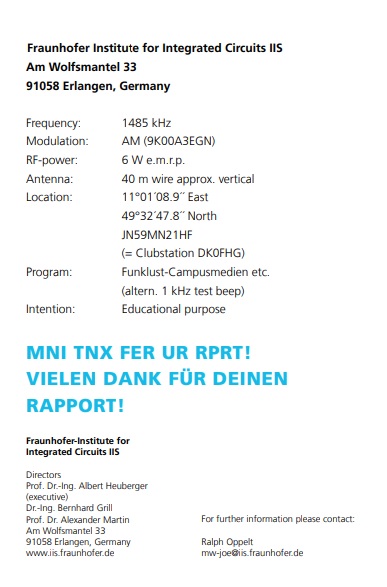
Per l'intero periodo della Guerra Fredda l'informazione e la propaganda ebbero un ruolo importantissimo nella contrapposizione tra i due blocchi. Il mezzo radiofonico ebbe un ruolo fondamentale in questo conflitto ed entrambe le parti non lesinarono mezzi e risorse per combattere la guerra dell'informazione (e della disinformazione). Insieme alle radio ufficiali dei Paesi coinvolti, furono create una serie di radio clandestine che trasmettevano a tempo pieno nelle lingue nazionali dei Paesi che si volevano raggiungere. Tra le numerose radio clandestine che operarono d'oltrecortina, dal 1958 e per 30 anni operò anche Bizim Radio (La nostra radio) che aveva come target la Turchia, importante partner mediorientale della NATO. L'emittente si poneva come radio "locale" e lo staff era composto da persone di madrelingua affiliate al Partito Comunista Turco, che aveva comunque una sua emittente "ufficiale" . Quasi inutile sottolineare che la radio trasmetteva attraverso le potenti stazioni dell'Europa orientale, nello specifico da Magdeburgo nell'allora Germania Est. che Nei giorni scorsi ho ritrovato nel mio archivio una vecchia registrazione, presumibilmente dei primi anni 80, con il segnale di intervallo e l'inizio delle trasmissioni di Bizim Radio, un interessante documento sono originale riproposto in questo articolo.
La registrazione era sua una audiocassetta da poco riversata in formato digitale . Facendo delle ricerche in rete mi sono imbattuto invece in un documento pubblico del Dipartimento di Stato americano del Dicembre 1982 intitolato "Communist clandestine broadcasting" che analizza la situazione dell'emittenza clandestina d'oltre cortina in quel periodo. Dal documento si ricavano anche frequenze e orari di trasmissione dell'emittente:
Our Radio
Broadcast
Time: 0300-0350, 0500-0550, 0500-0530,
0700-0750, 0900-0950, 1015-1045, 1100-1150,
1300-1350, 1445-1515, 1500-1550, 1700-1750,
1740-1810, 1900-1950, 2000-2030, 2030-2100,
2100-2150 GMT
Frequency Usage: 11820, 9585, 9500, 6200 KHz
Questo il passaggio riguardante nello specifico Bizim Radio, ma la sua consultazione è molto interessante anche relativamente ad altre realtà radiofoniche clandestine di quel periodo.
At the present time, the only clandestine stations still operating
from Eastern Europe are two that broadcast in Turkish. Technical
observations indicate that both use facilities in Magdeburg, East
Germany. Bizim Radyo (Our Radio) was established in 1958, one year
after clandestine broadcasts to Greece and Iran were initiated; the
Voice of the Turkish Communist Party (VOTCP) was inaugurated in
1968 with broadcasts to Turkish emigrant workers in West Germany
and began broadcasting to Turkey itself in late 1974.
These radios generally have followed the Soviet line in commenting on Turkish foreign policy, emphasizing themes designed to
discredit the United States, NATO, and the West on a wide range of
issues. • On Turkish-U.S. relations, the radios have warned Turkey to
rid itself of American and NATO influences which they charge deprive
it of national independence, undermine its economy, and threaten its
national security. Clandestine broadcasts have continuously sought to
engender opposition to U.S. military bases in Turkey by appealing to
Turkish national pride. Terming the dismantling of the bases as a
priority task’’ of the Turkish people, the broadcasts depict the U.S.
military presence in Turkey as aimed first and foremost’’ against
Turkey’s national independence as well as against the Soviet Union
and the Socialist countries.
• Concurrently, the broadcasts have consistently promoted
closer Turkish-Soviet cooperation, arguing that this would free
Ankara from dependence on the West-said to be the cause of
Turkey’s political, social, and economic problems-and contribute to
the Turkish people’s struggle for national and social liberation.
LINK
For the entire period of the Cold War, information and propaganda played a very important role in the contrast between the two blocs. The radio medium played a fundamental role in this conflict and both sides spared no means and resources to fight the war of information (and disinformation). Together with the official radios of the countries involved, a series of clandestine radios were created that broadcast full time in the national languages of the countries they wanted to reach. Among the numerous clandestine radios that operated beyond the Curtain, from 1958 and for 30 years also Bizim Radio (Our Radio) which had as its target Turkey, an important Middle Eastern partner of NATO. The broadcaster posed itself as a "local" radio station and, like other similar broadcasters, the staff consisted of native speakers affiliated with the Turkish Communist Party, which still had an "official" station. It is almost useless to point out that the radio was broadcasting through the powerful transmitters of Eastern Europe, specifically from Magdeburg in the then East Germany. In recent days I found in my archive an old recording, presumably from the early 80s, with the interval signal and the beginning of Bizim Radio broadcasts, an interesting original document re-proposed in this article..
The recording was his on an audio cassette recently released in digital format. While doing some research on the net, I came across a public document from the US State Department dated December 1982 entitled "Communist clandestine broadcasting" which analyzes the situation of clandestine broadcasting beyond the curtain at that time. The document also shows the broadcasting frequencies and times of the broadcaster:
























